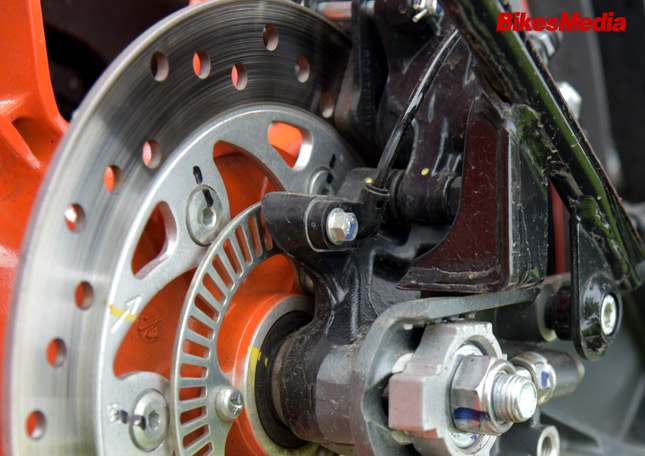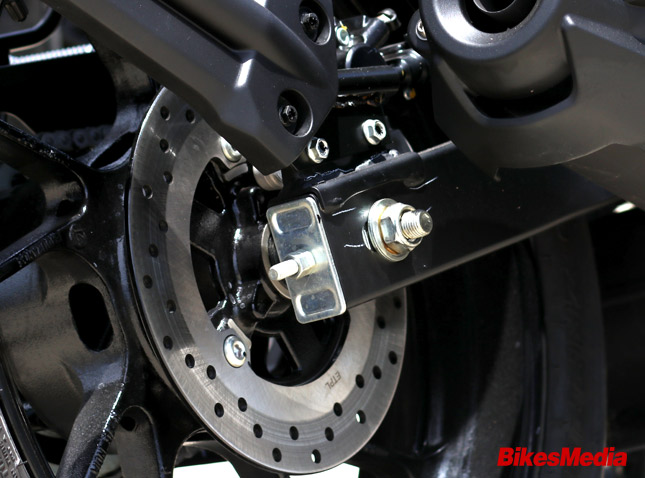 Also known as Sliding Caliper serves the same purpose as Fixed Brake Calipers. The main difference between the floating and fixed brake calipers is the mounting, one isn’t solidly mounted and the other is. Usually, the fixed brake calipers are present in vehicles able to attain high speeds or with a huge amount of weight which translates to a huge momentum thus justifying the need for a fixed brake caliper.
Also known as Sliding Caliper serves the same purpose as Fixed Brake Calipers. The main difference between the floating and fixed brake calipers is the mounting, one isn’t solidly mounted and the other is. Usually, the fixed brake calipers are present in vehicles able to attain high speeds or with a huge amount of weight which translates to a huge momentum thus justifying the need for a fixed brake caliper. RELATED ARTICLE: Floating Type Motorcycle Disc Brakes- All you need to know
Floating Brake caliper is good enough for most of the vehicles and can easily incorporate features like ABS in them. Let’s take a look at the functioning these floating brake calipers and how do they perform a range of functions like providing supplementary braking to decreasing cost of production.
Construction and Working of the Floating Brake Calipers:
In Floating type Disc Calipers the bracket is solidly mounted enabling it to slide left and right with the help of pins and bushings on the bracket. When the lever is pulled the fluid from the master cylinder flows into the piston which makes the brake pads rub against the disc. The setup includes the disc brake solidly mounted on the wheel present between the calipers which contains piston and brake pads on the side while the other compensates by sliding towards the disc.
RELATED ARTICLE: How Motorcycle Disc Brakes Work
When the lever is pulled the brake fluid generates a transferable non-compressible force which travels all the way to pistons present in the calipers which cause one side of the brake pad to push against the steel disc and moves the other one in the direction of the disc effectively stopping the bike.
This is the simple working and setup of these kinds of brakes, as it is evidently clear that absence of piston on another side of the brake pads and a sliding mechanism translates to fewer parts required in manufacturing them while still giving superior performance over drum brakes setup. The inclusion of fewer parts also makes them lighter and more compact.
RELATED ARTICLE: Why Disc Brakes Are Better Than Drum Brakes?
Now the area where these floating brake calipers fail is in supplying immediate bite feedback in case of emergency braking or during a track day. The sliding mechanism though theoretically work good enough but is not enough to apply enough squeeze onto the disc. To see understand more easily let’s compare it with Fixed type caliper brakes.
Fixed calipers setup consists of pistons on both sides of the brake pads, you can learn more about Fixed Brake Calipers in detail here. The lever is pulled and the fluid flows into the solidly mounted brake caliper causing brake pads on both sides to push towards the disc brakes because of pistons being present on both sides and a solid mounting setup.
RELATED ARTICLE: Why Holes Are Put On The Disc Brakes
To do this practically, keep a plate between your hands and try to push it with both of them once then put the same plate between both hands again, only this time keep one fixed and push from the other one. You will instantaneously understand the increase in force applied in both cases and how that force can make a huge difference in emergency scenarios.
 Not just Calipers:
Not just Calipers:Don’t feel disheartened as braking performance is determined by a ton of factors ranging from Brake Fluids and material for the disc to humidity and road conditions. So one of them isn’t playing nice with you, feel free to change the other ones. Talking about Floating Disc calipers, we have less bite, so we can fix them by using better brake pads and a more sticky rear tyre.
You can also try Bleeding your Brakes every once in a while to keep the bite ferocious. If we go deep then there is one more variable to play around with. Total piston area and rotor width also affect the stopping power a great deal. A personal gross estimate related to piston diameter can be to double the size to double the performance as it should be able to replicate the braking of a fixed caliper with half the diameter pistons of opposite ends.
Final Words:
I’d suggest going through all that I have talked about Floating calipers above one more time. Not because I want you guys to take a note of my narcissistic behavior but I would really love some feedback from you guy, especially if anyone of you has any experience in repairing or modifying calipers. Resuming the above topics, you must have noticed in the above paragraph that I have mentioned: “Sticky rear tyre” for improving braking performance of Floating calipers because be it Suzuki Gixxer or Apache RTR 160 rear disc brake on most of them is a floating setup because of all the reasons mentioned at the start.
For everything related to bikes, their components and a lot of discussion about riding, stay tuned to BikesMedia.
By: Yetnesh Dubey











